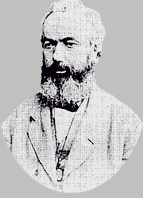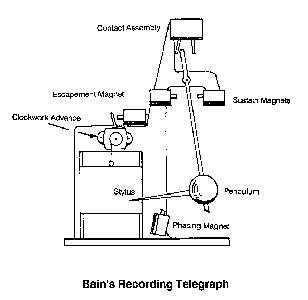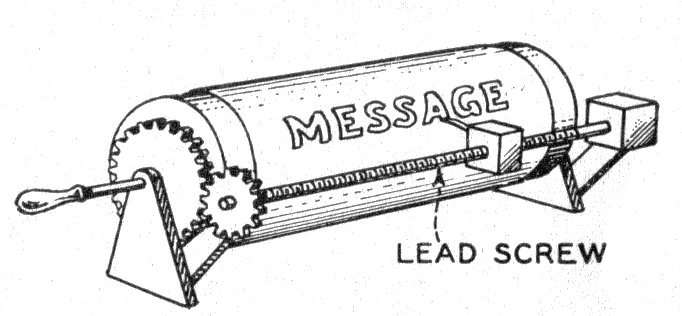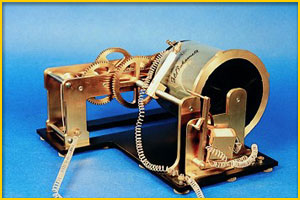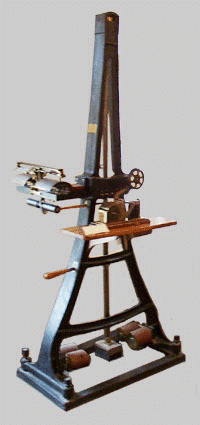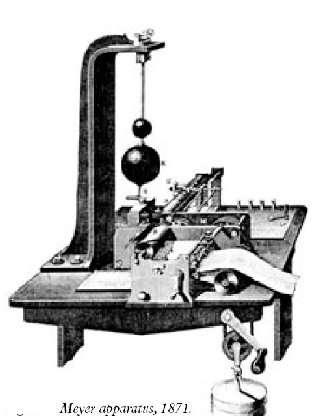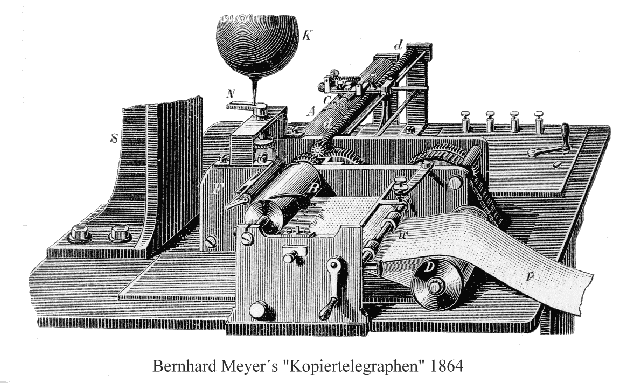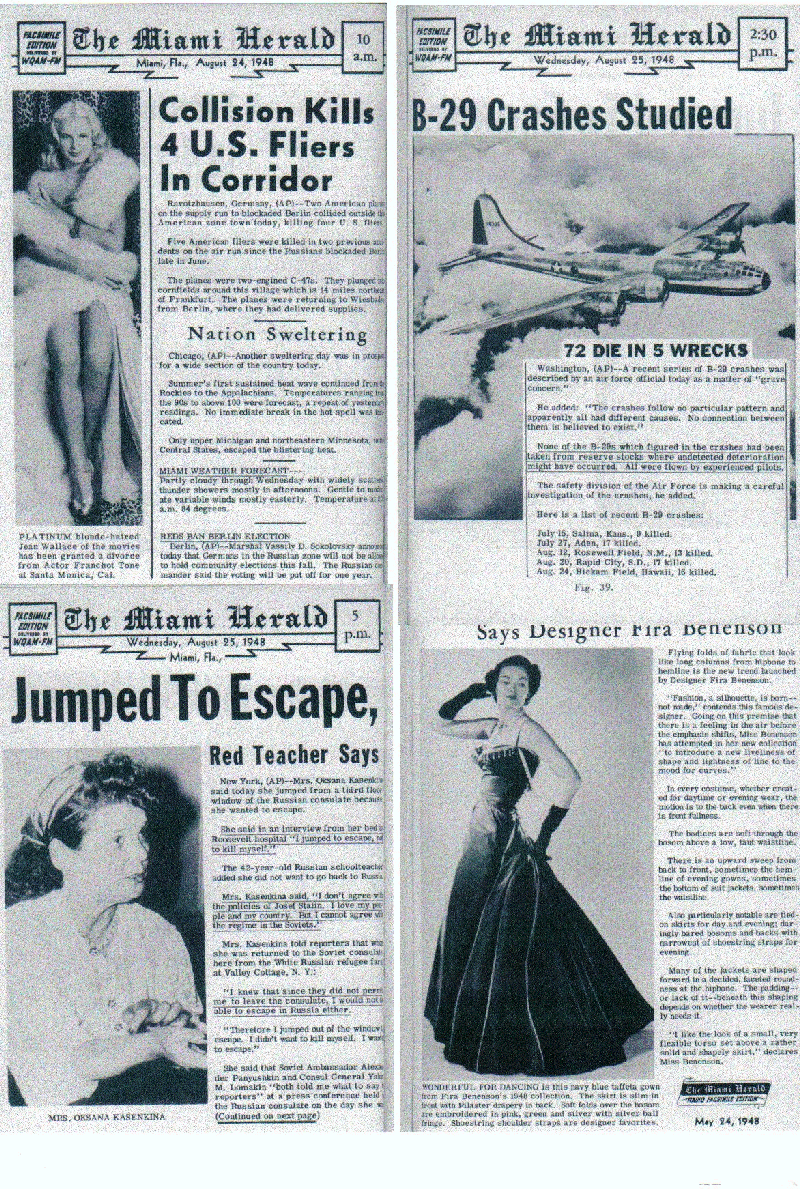|
|
|||||||||||||||||||||||||||
Click Here Fax History
For all who has interesting in the facsimile history, this site gives a bibliography of references, articles, publications and Books, refer to the history of facsimile. I believe this facsimile dokumentation is rare, and never seen on the web. Supplemented, and revised by Marius Rensen HISTORY AND DEVELOPMENT OF FACSIMILE
Facsimile transmission has been loosely defined as the means of creating an exact copy of a document at a distance. Transmission of graphic material, in either printed or pictorial form, may be via the public service telephone network (PSTN), private circuit or radio link. The first facsimile equipment for use in communications was the chemical telegraph invented by Alexander Bain (1810-1877) in 1842 and patented during the following year. This consisted of a metallic contact resting on a moving paper slip saturated with an electrolytic solution. The wire and the tape formed part of an electric circuit and when current flowed, discoloration of the tape occurred.
It is thought that the first working model of Bain's chemical telegraph was constructed and operated at about the time of the World Fair held in London in 1851. At this fair a second facsimile machine was demonstrated by Bakewell, who had been granted the relevant patent in 1848.
In principle the two machines operated in similar fashion using damp electrolytic paper as a recording medium and relied for transmission on a scanning stylus being in physical contact with the text of the message, the text being in relief form with raised lettering. Both systems also depended on associated pendulums and electromagnets for synchronisation. The Bain machine was essentially a flat bed machine while in Bakewell's model the relief text and receiving electrolytic papers were wound on drums. For many years the development of facsimile equipment was directed towards improving the mechanics of the scanning and reproduction functions. In 1865 the first working trials for a commercially viable facsimile machine was set up in France by an Italian, Caselli. Shortly after this Meyer facsimile machines were also tried out in the French telegraph systems.
Although the Caselli and Meyer machines had been brought into service there were still two major areas of difficulty to be investigated: synchronisation and contact transmission. A practical method of synchronising the early facsimile machines was finally worked out, and culminated in the La Cour tuning fork controlled motor synchronisation. Facsimile was first used commercially in France as an electromechanical telegraph. In 1870 there were some 17 Meyer facsimile instruments in service in the French telegraph system in conjunction with 4000 electromechanical telegraph machines. It appears that the facsimile facility was used to a large extent by the French government and to carry information relating to stockbroking. The main advantages seen at this time were the virtual elimination of errors in transmission and the availability of a facsimile signature.
The contact type transmitters used up to the early years of the 20th century were not satisfactory and limited the speed of transmission via facsimile. This was overcome through the development of a suitably sensitive photoelectric cell by Dr Arthur Korn of Germany in 1902, and his application of this cell to phototelegraphy work. The technique of this system was to transmit light through a photographic negative of the original, wound on a glass cylinder, to a photocell which converted the light pulses to electrical signals. The receiving medium was sensitised paper and the picture was reproduced in positive form. By 1910 Korn had established phototelegraphy links from Berlin to Paris and London, and in 1922 successfully transmitted by radio a picture from Rome to New York. In 1926 a commercial radio link for facsimile working was opened between the London office of the Marconi Wireless and Telegraph Company, and the New York office of the RCA.
The need to have material photographed to provide a negative for transmission, and the consequential high cost of the equipment developed on this principle, led to further research, and a system of transmission based on reflected light was evolved. In 1935 the Associated Press of the USA installed a country-wide network based on this system. By the 1920s pictures for publication in newspapers were being transmitted around the world. Later developments of the service in the 1930's included the introduction of weather maps and wire photo services. Technology had improved sufficiently beyond the late 19th century equipment to ensure that facsimile was a technically viable proposition even though the basic techniques and concept were unchanged.
Among the later adaptations of facsimile service by a telegraph company was that of the Western Union in the 1930s when they made facsimile machines available in public places for the transmission of messages to the nearest Western Union office. The message was then forwarded from the office in the normal telegraph manner. Unfortunately this system proved prone to vandalism and was phased out. Western Union was involved in another similar venture: "Desk Fax" introduced in 1948. Using this system private companies who rented transmitters were able to send short messages via a Western Union telegraph office.
The main area in which facsimile proved successful in augmenting telegraph facilities was in the transmission of photographs i.e. phototelegrams - mainly newspaper pictures, but also pictures of documents, machine drawings and fingerprints. This service grew from the start of the New York - London link in 1926 and continued to thrive. By 1950 access to 24 countries was available and in 1963 the Post Office phototelegraphic system was operating services to and from 56 European terminals and 38 extra-European terminals. In January 1976 these figures were 47 and 51 respectively to a total of 65 countries. The success of phototelegraphy was not reflected in other uses devised for facsimile. Attempts to introduce home news broadcasts in manuscript form and thus bring facsimile into the residential market failed. Such systems were tried as early as 1929 in America and throughout the 1930s. Once television was introduced there was no possibility of facsimile competing. As a telecommunications medium facsimile remained from the 1930's to the early 1960's essentially a system for specialised applications with sophisticated expensive machines - the two main sections of use being in distributing weather charts and in the newspaper industry. Although suitable telephone coupling devices were available from the 1930s it was not until the 1960s that relatively cheap facsimile machines were available for connection to the PSTN. Growth in the market was prompted by declining postal services in the USA, and in Japan by the pictorial nature of the alphabet. These new machines became known as document facsimile machines and were used for transmitting handwritten, typed or printed text and drawings. A contributory factor to the late development of a simple dial-up facsimile unit was the relatively late stage at which solid state techniques were introduced to the facsimile system. Europe lagged behind the USA and Japan, but early growth followed agreed standards on machine design by the International Telegraph and Telephone Consultative Committee (CCITT). The introduction of Group 1 standard in 1968 was a significant step in the development of facsimile, despite slow and unreliable terminals and lack of full compatibility. It took 6 minutes to transmit an A4 page, but the machine stimulated interest in the concept of sending text and graphic material by telephone around the world instead of heavy reliance on the postal service. A Group 2 standard was agreed in 1976, which halved the time of transmission to 3 minutes and improved quality with a scanning density of 100 lines per inch. But the density remained unsatisfactory for sending documents containing small print and the time for transmission still meant that a 10 page document took half an hour to receive. A further CCITT standard was agreed in 1980 for Group 3 machines, which used digital transmission techniques and took less than one minute per page with an improved scanning resolution of 200 lines per inch. All were compatible and could communicate with most Group 2 machines regardless of supplier. [This article was contributed by the BT Archives and Historical Information Centre]
(C) Marius Rensen |
